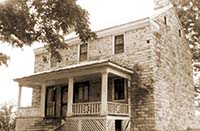from Tennessee Potteries, Pots and Potters- 1790s to 1950, Volume 1 by
Samuel D. Smith and Stephen T. Rogers
Thomas Ripley, Sr. was born in Northumberland County, Virginia around 1770, but was in Greene County by 1790, when he married Phoebe Stanfield. He is assumed to be the actual owner of an earthenware pottery described in 1820. The person mentioned on the manufacturers census schedule may have been his son, Thomas Ripley, Jr. The accepted death date for Ripley, Sr. is 1823.
Information concerning a Ripley pottery comes from the 1820 census of manufacturing establishments. The schedule describes a small earthenware pottery owned by Thomas Ripley. Unfortunately the census taker did not specify which of two Thomas Ripleys he was indicating, and it may never be entirely clear if it was the father, Thomas, or his son Thomas Ripley, Jr.
As it is now defined, site 40GN29 includes within its boundaries a well-constructed stone house initially owned by the elder Thomas Ripley. This is one of several similar East Tennessee stone houses built during a period from the late 1700s to the early 1800s and much studied for their architectural merit. It is believed the Ripley house was constructed before 1810.
Thomas Ripley, Sr. was born in Virginia but was in Greene County by 1790. He began purchasing land in the early 1790s and by 1816 owned over 600 acres. By 1820 he was a wealthy man.
At the time of the 1820 census of manufacturing establishments, Thomas Ripley, Jr. was between 18 and 19 years of age. After his father died in 1823, he appears to have stayed on at the homeplace. After his mother died in the early 1840s, he bought out the other heirs’ interests in the estate, including the "dwelling or mansion house" where his parents had lived. He lived until 1862 and was called a farmer on later census reports.
Were it not for certain comments made by the 1820 census taker, it would seem a simple assumption that the elder Thomas Ripley was merely the owner of a small pottery that had one man working there. Those comments, however, cast doubt on who was doing what, for they state in part
the proprietor is almost continually intoxicated. It was impossible to get satisfactory answers to the questions.
It is difficult to believe that Thomas Ripley, Sr.’s apparent success in life would have been compatible with a state of near constant intoxication. This may leave as the only alternative that it was his son, Thomas Jr., who is named as the proprietor, and in early adulthood, was struggling with a drinking problem, while perhaps trying to forget his own profession as a potter. As already stated, none of this can be known for certain, and there may even be doubt that the census taker’s use of the term "proprietor" was specifically directed at either of the Ripleys. As defined by most dictionaries, proprietor can mean either a legal owner or someone who has a legal right of use without being the actual owner.
There is but one other clue found that suggests a connection between the family and pottery making. This is in a lengthy deed filed in 1824 to partition the land and other properties that had belonging to Thomas Ripley, Sr. Among the items that had been disbursed, in this case to son Henry Ripley, was $20 worth of "crockery ware." This was the same value assigned to a horse Henry had received (in terms of the values assigned to Ripley pottery in 1820, it suggests something like 160 crocks or similar size vessels). It seems too much earthenware for simple household use, implying there was a surplus amount related to manufacture. It is certainly a lot more than was found to be common in a study of upper East Tennessee household inventories of a somewhat earlier date.
The 1824 disbursement of crockery ware could possibly also signal the end of its production. It is simply not known how long before or after 1820 the Ripley pottery operated. During the year preceding the completion of the 1820 schedule, the ware was produced using local clay, with lead and brimstone used in glazing. Specifically there was a consumption of 300 pounds of lead and 40 pounds of brimstone, together valued at $57. Manufacturing equipment was limited to a "simple wheel for grinding the dirt" and a wheel for turning the ware. The annual production was
300 crocks @ 12 ¢,
100 milk pans @ 12 ½ ¢,
100 honey pots @37 ½ ¢,
100 jugs @16¢,and
100 pitchers @12 ½ ¢.
It was noted that this was
a small establishment not in a flourishing condition. The demand for the articles made is inconsiderable.
Also, because of the proprietor’s inebriated state
It was impossible to get satisfactory answers to the questions, but it is believed that what is manufactured more than doubles the account given.


